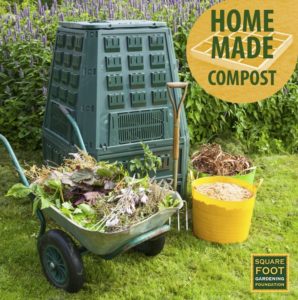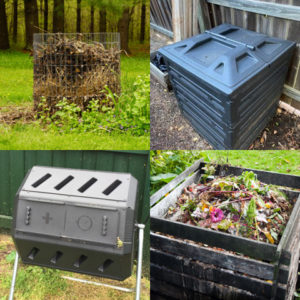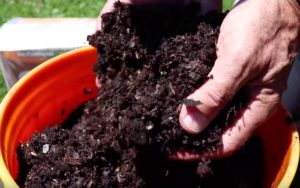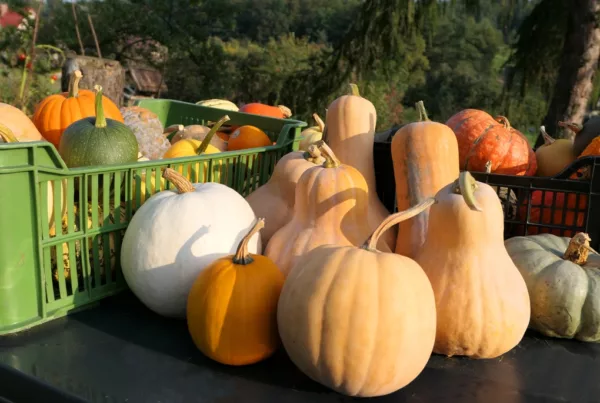Written by Chris McLaughlin
Anyone can pick up a bag of compost at the garden center, but do you know exactly what’s in there? Many home gardeners make their own compost, and Mel always said homemade was the best for your Square Foot Garden. Whether it’s to help reduce landfill wastes, upcycle kitchen scraps or know the exact source of their compost materials, gardeners know that making compost is anything but difficult.

Making your own compost is easy – nature does most of the work!
Why? Because nature does almost all the work!
Compost – one-third of Mel’s Mix™ – is the product of decomposed herbivore animal manure and plant matter. Although every living organism will eventually decompose naturally, we can speed up the process by starting a compost pile. Here’s why you’ll want your own:
- Compost is the most important ingredient in your Mel’s Mix™, providing all the nutrients your veggies need to thrive and eliminating the need to fertilize.
- Finished compost is basically a neutral pH (not too acidic, not too alkaline), making most vegetable plants extremely happy.
- Your Square Foot Garden needs some fresh compost each season to replenish the nutrients a harvest takes out of your Mel’s Mix™.
Creating a compost pile is easy and you’ll never regret having your own source of “black gold” ready for your SFG.
Container Options
Your compost pile can go directly on the ground! For those on a farm or living in rural areas, this is the easiest option. However, urban and suburban Square Foot Gardeners usually want to keep things contained for space and aesthetic reasons.

Compost containers can be homemade or store bought.
Buy compost or tumbling bins at your local hardware, big box store or garden center. I prefer the regular bin as opposed to the tumbling ones because I find the decomposing process goes faster when the materials are touching the ground. Organisms which are naturally in your soil accelerate the composting process. For tumbling bins, you can buy a packaged compost activator to get things going.
Want to make your own container? You can with these simple materials:
- Make a compost hoop using wire fencing to encircle steel T-posts (buy at big box or farm supply retailers).
- Make a three or four-sided bin using pallets (get them free from a loading dock) or fence panels. Watch our video with Steve Bartholomew as he builds a pallet bin.
- Leave the front open for easy access.
- Or, make a three-sided bin using stacked cinder blocks.
The location of your compost bin should be in a sunny, well-draining and level spot to avoid sitting in water from rain or lawn irrigation.
Make a Hot Compost Pile – Start with Mix and Mash
Ever scoop up woodchips from your municipal giveaway pile and you uncover a pocket of warm steam? That’s hot composting right there, where beneficial microbes are breaking down organic matter. A hot compost pile is also the fastest way to make more “black gold” for your SFG.
These microorganisms need green organic materials (which provide nitrogen), brown organic materials (which provide carbon), plus water and air to do their job.
Mel’s Four M’s composting rules help your hot pile “cook” efficiently as well:
- Mix: Add as many different, plant-based ingredients to the pile as you can find
- Mash: Chop everything up into small pieces
- Moisten: Keep the pile moist, not dry or soaking wet
- Move: Keep turning the pile towards the center where all the microbial action is
What Green and Brown Materials Can I Use?
Nitrogen-rich green sources for your Mix are dried grass clippings, tree leaves, wilted flower bouquets, green plant leaves, vegetable and fruit kitchen scraps (avoid the seeds), coffee grounds, tea bags, dead houseplants, fresh hay, freshwater algae and aquarium water. You can also add manure from herbivore (plant-eating) animals like rabbits, horses, cows, goats and poultry. *Do not add dog or cat (carnivore) manure.
As for carbon-rich brown Mix sources, they include cornstalks and corncobs, cardboard, paper-based egg cartons, shredded newspaper, paper towels, shredded documents (non-glossy), clean straw (without seeds heads), shredded dried leaves, shredded twigs and bark, pine needles, and sawdust (not from pressure-treated wood).
The finer you chop up these materials, the faster they decompose – hence “Mash.”
No Math Needed – Here’s Our Easy Compost Recipe
No measuring needed: all you do is add equal amounts of green and browns. If you add an armful of browns to the pile, add an armful of greens. Keep this going until you have a pile at least 3 x 3 x 3 feet, as a compost pile needs a certain amount of mass to activate microbes into a hot pile. Your pile can be bigger if you wish, too, but the larger it is, the harder it is to turn.
What’s Next? Moisten and Move

Finished compost feels fluffy and smells earthy.
Once you make your pile, add enough water (that’s the third M: Moisten) with a garden hose (set to “shower” on the nozzle) so it feels like a wrung-out sponge. Use a small shovel, rake, or pitchfork to turn it and make everything damp but not sopping. Then it’s time to Move: use a pitchfork to get air mixed into your pile and you’ve followed Mel’s recipe for success. Your compost pile is now up and running!
Maintain your pile by adding just enough water to keep the materials damp and keep turning it regularly to keep oxygen flowing. Otherwise the pile will cool down and it will take longer to break down. Turn the pile well about every two or three weeks.
Your compost is ready to use when it’s dark, crumbly and smells earthy like the forest floor. Mel recommended screening the large chunks out before using in your SFG (as Steve demonstrated in the video). Voila – delicious and nutritious homemade compost your veggies will love!
Learn more about the Square Foot Gardening Method by taking the introductory course.



